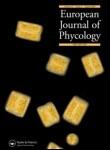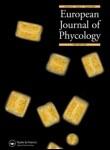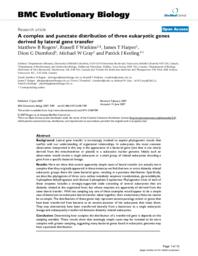Science and Technology
Related Works
Content type
Digital Document
Abstract
Small-subunit ribosomal DNA (SSU) sequences for 14 members of the rhodophyte order Acrochaetiales were used to generate phylogenetic trees to determine whether the Acrochaetiales is monophyletic and to assess the relationships of acrochaetioid algae to closely related taxa. Within the Acrochaetiales, two strongly supported groups are recognized: one group that includes, in addition to three other species, the type species of the genera Acrochaetium, Audouinella and Rhodochorton; and a second group that includes an unequivocal representative of Colaconema and nine additional species. The relationships of these groups with the Batrachospermales, Palmariales and Nemaliales were not resolved and the possibility that the Acrochaetiales is polyphyletic was not eliminated. Resolution of relationships for species within these groups was strong in only a few cases, with many of the phylogenetic issues at this level remaining equivocal. Our results do not position Camontagnea in the Acrochaetiales, as has recently been suggested, but strongly ally this genus to the family Rhodothamniellaceae of the Palmariales. The phylogenetic position of Rhododraparnaldia, an alga intermediate between the Acrochaetiales and Batrachospermales, remains unresolved. These molecular results provide a foundation for assessing the taxonomic significance of phenotypic characters (e.g. anatomy, life histories, morphology, phycoerythrin type and plastid details) variously considered taxonomically significant in the Acrochaetiales.
Origin Information
Content type
Digital Document
Abstract
Systematics of the red algal order Acrochaetiales and related taxa was investigated using combined small- and large-subunit nuclear ribosomal DNA (SSU and LSU rDNA, respectively) sequence data. These data were subjected to distance, parsimony and maximum likelihood analyses. The resulting phylogenies were congruent with previously published SSU results in that all included orders (Balbianiales, Batrachospermales, Nemaliales, Palmariales and Thoreales) were resolved as monophyletic except the Acrochaetiales, which consisted of two lineages (Acrochaetiales I and II). The Batrachospermales and Thoreales occupied equivocal positions as early diverging lineages, while the Balbianiales generally resolved as sister to an Acrochaetiales–Nemaliales–Palmariales (ANP) complex. Relationships among the four lineages of the ANP complex were not completely resolved, but detailed analyses weakly positioned Acrochaetiales II as sister to the Nemaliales, whereas Acrochaetiales I displayed a moderate to strong affiliation with the Palmariales. Acrochaetiales I included representatives of the genera Acrochaetium, Audouinellaand Rhodochorton, whereas Acrochaetiales II had a number of acrochaetioid species including a representative of the genus Colaconema. Compared with published SSU phylogenies, bootstrap values within the two Acrochaetiales lineages increased substantially in combined SSU/LSU analyses. Based on these results, emended generic descriptions are provided for Acrochaetium, Audouinella, Colaconemaand Rhodochorton, and a new family of acrochaetioid algae is described, the Colaconemataceae J. T. Harper etG. W. Saunders. The Acrochaetiaceae now includes the genera Acrochaetium, Audouinellaand Rhodochorton, while the Colaconemataceae is considered monogeneric at this time. It is quite likely that additional genera will be recognized within the Colaconemataceae pending further investigation. Acrochaetiaceae is retained as the sole family of the Acrochaetiales, although the tenuous recognition of the Palmariales as distinct from this order is discussed, whereas Colaconemataceae is transferred to the new order Colaconematales J. T. Harper et G. W. Saunders.
Origin Information
Content type
Digital Document
Abstract
Background: Lateral gene transfer is increasingly invoked to explain phylogenetic results that conflict with our understanding of organismal relationships. In eukaryotes, the most common observation interpreted in this way is the appearance of a bacterial gene (one that is not clearly derived from the mitochondrion or plastid) in a eukaryotic nuclear genome. Ideally such an observation would involve a single eukaryote or a small group of related eukaryotes encoding a gene from a specific bacterial lineage.
<p>Results: Here we show that several apparently simple cases of lateral transfer are actually more complex than they originally appeared: in these instances we find that two or more distantly related eukaryotic groups share the same bacterial gene, resulting in a punctate distribution. Specifically, we describe phylogenies of three core carbon metabolic enzymes: transketolase, glyceraldehyde-3-phosphate dehydrogenase and ribulose-5-phosphate-3-epimerase. Phylogenetic trees of each of these enzymes includes a strongly-supported clade consisting of several eukaryotes that are distantly related at the organismal level, but whose enzymes are apparently all derived from the same lateral transfer. With less sampling any one of these examples would appear to be a simple case of bacterium-to-eukaryote lateral transfer; taken together, their evolutionary histories cannot be so simple. The distributions of these genes may represent ancient paralogy events or genes that have been transferred from bacteria to an ancient ancestor of the eukaryotes that retain them. They may alternatively have been transferred laterally from a bacterium to a single eukaryotic lineage and subsequently transferred between distantly related eukaryotes.
<p>Conclusion: Determining how complex the distribution of a transferred gene is depends on the sampling available. These results show that seemingly simple cases may be revealed to be more complex with greater sampling, suggesting many bacterial genes found in eukaryotic genomes may have a punctate distribution.
Origin Information
Content type
Digital Document
Abstract
This paper is a review, based largely though not exclusively on work from the authors' research group, of the role of Ca2+ channels in the actions of ethanol. The position is taken that an important consequence of the presence of ethanol in the region of excitable cells is a reduction in voltage-activation of membrane ion channels with a resulting decrease in cellular excitability. We suggest that excitable cells adapt to this effect by increasing the number of Ca2+ channels on the cell membrane. The channels are of a subtype which are inhibited by the dihydropyridine Ca2+ “antagonist” drugs. Although the mechanism of Ca2+ channel up-regulation is an effective short-term measure as adaptation against the acute effects of ethanol, we consider it may have detrimental longer term consequences including physical dependence and alcohol-related pathology including the death of excitable cells.
Origin Information
Content type
Digital Document
Abstract
Male Sprague-Dawley rats were made physically dependent on ethanol by exposure to ethanol vapour in inhalation chambers for 6–10 days. Animals were sacrificed immediately after removal from the chambers. After sacrifice, membrane preparations from cerebral cortex, heart, vas deferens and thigh skeletal muscle were prepared and studied to determine the characteristics of [3H]-nitrendipine binding. In membranes from cerebral cortex, the number of binding sites (Bmax) was increased 40% in preparations from ethanol-dependent rats compared to controls. Similar results were obtained in heart (Bmax increased 125%). vas deferens (Bmax increased 50%) and skeletal muscle (Bmax increased 33%). Binding affinity (Kd) in all these tissues was unchanged. Membranes from cortex and heart were studied more extensively. Displacement studies using other dihydropyridines and the effects of ionic composition on [3H]-nitrendipine binding provided no evidence to suppose that the binding sites induced by the development of ethanol dependence were from a population different from those in ontrol tissues. The results suggest a generalised ‘up-regulation’ of the dihydropyridine-sensitive subclass of voltage operated calcium channels in excitable tissues from ethanol-dependent rats.
Origin Information
Content type
Digital Document
Abstract
The genus Leptocereus comprises about a dozen species endemic to the Caribbean. The majority of these species are endemic to Cuba and all of them are threatened by extinction. In this paper, the flowers of L. scopulophilus are characterized considering the inner diameter of the perianth, the deep of the nectar chamber and the length of the floral tube. Flower development is described taking into account the anthesis, and the production and concentration of nectar. The mating system of this species is determined and flower visitors and pollinators are identified. The diameter inner of perianth is 1,84 cm, the length of floral tube is 2,16 cm and the deep of nectar chamber is 0,62 cm. The anthesis occurs in the afternoon around 18:30, the production of nectar begin among 21:00 and 22:00 and is extend until 10:00 of the next day, while the nectar concentration vary among 19,4 % and 16,2 % of sacarose. L. scopulophilus is exclusively out crossing and self-incompatible species. The flowers have a syndrome of chiropterophillous pollination, however, 14 visiting species have been identified. Only the nocturnal pollination by Monophyllus redmani bat is successful.
Origin Information
Content type
Digital Document
Abstract
The effects of different local food resources on the diets of some filipalpian stonefly nymphs (Aphanicerca spp.) were investigated. Animals from two headwater reaches, one primarily allochthonously driven and the other an open-canopied autochthonous-based system were compared. However, gut and stable carbon isotope analyses revealed no real differences in plecopteran diets between the systems, with leaf detritus being a major source of carbon, and algae contributing virtually nothing to their diets. δ15N analysis suggested that the animals obtained their nitrogen from sources other than leaf material itself, and it was hypothesized that this source was the microbial slime layer formed on decomposing leaves. It was concluded that the feeding behaviour of Plecoptera is consistent with that of shredders of leaf detritus, and as such they uphold River Continuum Concept predictions of large shredder populations being indicative of a predominance of coarse particles in headwater reaches. This study also highlighted the danger of making broad generalisations as to an organism's diet, based on the overall nature of the system, rather than on the micro- level of what may actually be available to small populations within a species.
Origin Information
Content type
Digital Document
Abstract
The relationships between the standing stocks of deposit-feeding benthic invertebrates and benthic chlorophyll-a, phaeopigment and total combustible organic matter were investigated at a series of coastal lagoons and in the type of intertidal soft-sediment sites from which the lagoons originated. Across all the sites, in Norfolk, UK, an inverse relationship occurred between (a) the amounts of chlorophyll-a and of other potential food materials and (b) the degree of coverage by water. The biomass of consumers also decreased with increased water coverage, so that the lagoons supported less biomass than the adjacent high-level intertidal sites. Further, the deposit-feeder biomass supported by unit food decreased with extent of water coverage.There was no evidence of any relationship between deposit-feeder and food biomass within any single site, in spite of the study period being selected to be that in which there was maximum likelihood of competition for microphytobenthic food. Whilst chlorophyll concentrations may set the maximum achievable level of consumer biomass at these sites, including in the deeper lagoons setting very low potential maximum population densities, the seasonal abundance patterns of the deposit feeders appear to be determined by other factor(s). [ABSTRACT FROM PUBLISHER]
Origin Information
Content type
Digital Document
Abstract
Glutathione serves the function of providing reducing equivalents for the maintenance of oxidant homeostasis, and besides it plays roles in intra- and intercellular signaling in the brain. Our purpose was to test the effects of depleting tissue glutathione by diethylmaleate (5.3 mmol/kg, intraperitoneal) on brain antioxidant metabolism, nerve growth factor levels, and cognitive performance in rats. Six hours after the treatment, glutathione level in the hippocampus dropped down to 30% of the mean value of vehicle-treated animals and glutathione peroxidase activity also declined. Twenty-four hours after the injection the values had been partially restored. Moreover, the hippocampal and cortical levels of nerve growth factor protein did not change in response to diethylmaleate treatment. Glutathione depletion did not influence the performance of animals in the step-through passive avoidance test, but impairs acquisition in the Morris water maze when given before training. However, when diethylmaleate was administered after acquisition in the same paradigm, it did not affect the retention tested at the following day. Our results suggest that glutathione status is important during acquisition, but not for retention, of spatial memory in maze tasks and they support the hypothesis of the oxidant/antioxidant equilibrium as a key piece acting in the regulation of brain function.
Origin Information
Content type
Digital Document
Abstract
ALS2 is an autosomal recessive form of spastic paraparesis (motor neuron disease) with juvenile onset and slow progression caused by loss of function of alsin, an activator of Rac1 and Rab5 small GTPases. To establish an animal model of ALS2 and derive insights into the pathogenesis of this illness, we have generated alsin-null mice. Cytosol from brains of Als2 mice shows marked diminu- tion of Rab5-dependent endosome fusion activity. Furthermore, primary neurons from Als2 mice show a disturbance in endo- somal transport of insulin-like growth factor 1 (IGF1) and BDNF receptors, whereas neuronal viability and endocytosis of trans- ferrin and dextran seem unaltered. There is a significant decrease in the size of cortical motor neurons, and Als2 mice are mildly hypoactive. Altered trophic receptor trafficking in neurons of Als2 mice may underlie the histopathological and behavioral changes observed and the pathogenesis of ALS2.
Origin Information





![Binding characteristics of the calcium channel antagonist [3H]-nitrendipine in tissues from ethanol-dependent rats Journal cover](/_flysystem/repo-service/styles/solr_grid_thumbnail/repo-bin/2025-10/0735-0414.png.jpeg?itok=oJb-cuYs)




